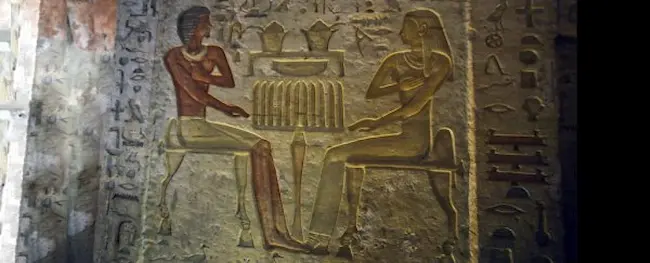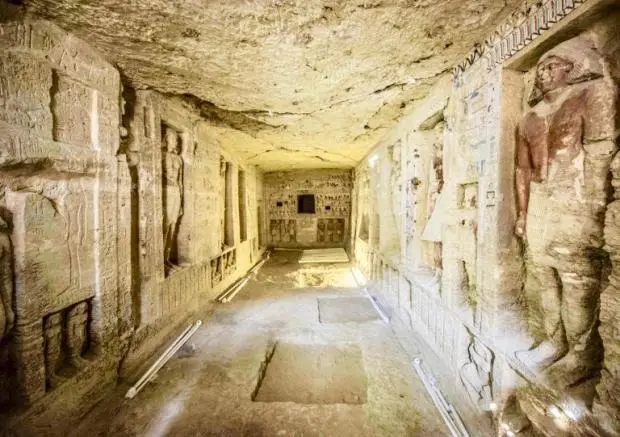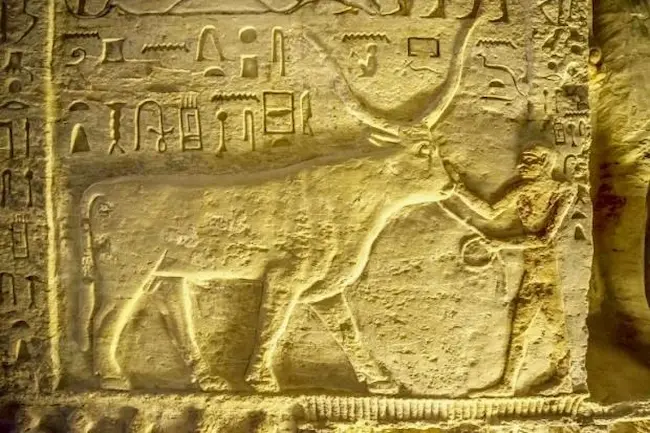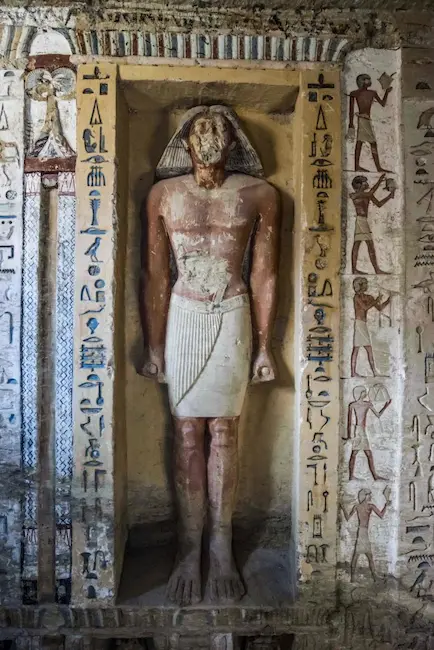A priest’s tomb, which is believed to be over 4,400 years old, was recently discovered by Egyptian archaeologists in the Pyramid complex of Saqqara, south of the country’s capital, Cairo.

Khaled el-Enany, the Minister of Antiquities, stated that the tomb was remarkably well-preserved and adorned with colored sculptures. The tomb is located in an ancient necropolis of Saqqara, where it had remained untouched and unlooted.

The tomb is unique and belongs to a high-ranking official priest named “Wahtye,” who served during the reign of King Neferirkare in the fifth dynasty. The 33-foot-long, three-meter-wide, and three-meter-high tomb is decorated with hieroglyphs and statues of pharaohs, with intact colors despite its age.

Archaeologists found five shafts inside the tomb, with one shaft unsealed and the other four still sealed. They expect to make more discoveries when they start excavating the sealed shafts on Sunday. Officials are hopeful about one particular shaft that may lead to a coffin or sarcophagus of the tomb’s owner.

In November, seven sarcophagi were discovered in Saqqara, some of which were over 6,000 years old. The Saqqara necropolis is also known for the Djoser pyramid.
What does the tomb tell us about the Fifth Dynasty?
The tomb of Wahtye provides a wealth of new information about the Fifth Dynasty, including its culture, art, and religion. Here are some of the key takeaways from the discovery:
- The Fifth Dynasty was a time of great prosperity and wealth. The tomb of Wahtye is filled with stunning artifacts that demonstrate the wealth and power of the Fifth Dynasty.
- The Fifth Dynasty was a time of great artistic achievement. The statues, jewelry, and pottery found in the tomb of Wahtye are all examples of the high level of artistic achievement that was reached during the Fifth Dynasty.
- The Fifth Dynasty was a time of great religious devotion. The tomb of Wahtye is filled with religious symbols and imagery, which shows that the Fifth Dynasty was a time of great religious devotion.
The significance of the discovery
The discovery of the tomb of Wahtye is a major archaeological coup. It is one of the most significant archaeological discoveries in Egypt in recent years. The tomb provides a wealth of new information about the Fifth Dynasty, one of the most important periods in Egyptian history. The discovery is a major step forward in our understanding of Egypt’s ancient history, and it is sure to generate further research and scholarship.
Frequently Asked Questions
- What is the significance of the tomb of Wahtye?
- What does the tomb tell us about the Fifth Dynasty?
- What are the most intriguing artifacts found in the tomb?
- What are the implications of the discovery for our understanding of Egypt’s ancient history?
- What are the next steps for research on the tomb of Wahtye?
I hope this article has been informative and interesting. If you have any further questions, please feel free to ask.
Here are some additional details about the tomb of Wahtye:
- The tomb is located in a buried ridge at the Saqqara necropolis, about 20 kilometers south of Cairo.
- The tomb is about 10 meters deep and 5 meters wide.
- The tomb is decorated with scenes of Wahtye and his family, as well as religious symbols and imagery.
- The tomb is filled with stunning artifacts, including statues, jewelry, and pottery.
- The statues are made of limestone and wood, and they depict Wahtye and his family.
- The jewelry is made of gold and precious stones, and it is exquisitely crafted.
- The pottery is decorated with colorful scenes of daily life.
- The tomb is still being excavated, and more artifacts are expected to be found.
The discovery of the tomb of Wahtye is a major archaeological coup, and it is shedding new light on Egypt’s ancient history. It is the first time that an untouched tomb from the Fifth Dynasty has been discovered, and it is providing valuable insights into this important period of Egyptian history. The discovery is a major step forward in our understanding of Egypt’s ancient history, and it is sure to generate further research and scholarship.

